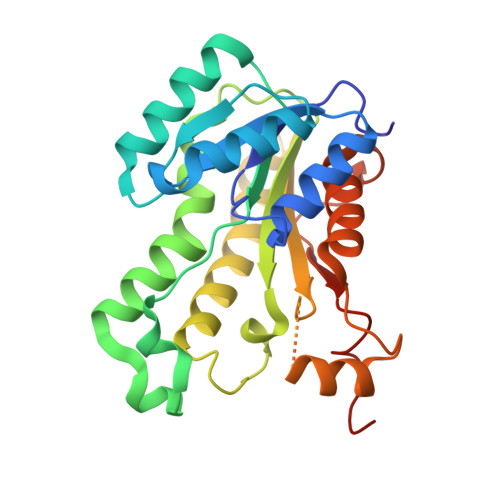Discovery of aminopyridine-based inhibitors of bacterial enoyl-ACP reductase (FabI).
Miller, W.H., Seefeld, M.A., Newlander, K.A., Uzinskas, I.N., Burgess, W.J., Heerding, D.A., Yuan, C.C., Head, M.S., Payne, D.J., Rittenhouse, S.F., Moore, T.D., Pearson, S.C., Berry, V., DeWolf Jr., W.E., Keller, P.M., Polizzi, B.J., Qiu, X., Janson, C.A., Huffman, W.F.(2002) J Med Chem 45: 3246-3256
- PubMed: 12109908
- DOI: https://doi.org/10.1021/jm020050+
- Primary Citation of Related Structures:
1LX6, 1LXC - PubMed Abstract:
Bacterial enoyl-ACP reductase (FabI) catalyzes the final step in each cycle of bacterial fatty acid biosynthesis and is an attractive target for the development of new antibacterial agents. Our efforts to identify potent, selective FabI inhibitors began with screening of the GlaxoSmithKline proprietary compound collection, which identified several small-molecule inhibitors of Staphylococcus aureus FabI. Through a combination of iterative medicinal chemistry and X-ray crystal structure based design, one of these leads was developed into the novel aminopyridine derivative 9, a low micromolar inhibitor of FabI from S. aureus (IC(50) = 2.4 microM) and Haemophilus influenzae (IC(50) = 4.2 microM). Compound 9 has good in vitro antibacterial activity against several organisms, including S. aureus (MIC = 0.5 microg/mL), and is effective in vivo in a S. aureus groin abscess infection model in rats. Through FabI overexpressor and macromolecular synthesis studies, the mode of action of 9 has been confirmed to be inhibition of fatty acid biosynthesis via inhibition of FabI. Taken together, these results support FabI as a valid antibacterial target and demonstrate the potential of small-molecule FabI inhibitors for the treatment of bacterial infections.
Organizational Affiliation:
GlaxoSmithKline Pharmaceuticals, 1250 South Collegeville Road, P.O. Box 5089, Collegeville, PA 19426, USA. william_h_miller@gsk.com
















